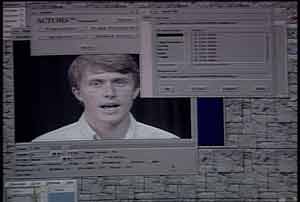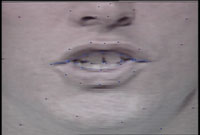Think you must dress for success even in the bold new world of telecommuting?
Maybe not, even if your employer has a videophone to display your
image.
Courtesy
of the Jet Propulsion Labratory managed by CalTech.
A digital human-image animation computer system under development
at NASA's Jet Propulsion Laboratory, Pasadena, Calif., can use the
smallest units of speech, called phonemes, to manipulate a person's
facial movements in an image. The system is driven by language rather
than by manual animation controls. While development is in the early
stages at this point, the eventual result will be photo-realistic
animation of a person speaking.
"This is voice-driven, so the image morphs in response to a voice
or equivalent input," said principal investigator John Wright of
JPL. "Real-time animation is a key step in our development process.
Unlike cartoon morphs, this technology uses video and facial movements
of real people as its building blocks."
The
system, called Digital Personnel, will make it possible to use an
image of any human face and make it appear to be speaking naturally.
With a videophone, it would be possible to have the option of always
portraying the image you wish - no more "bad hair days." or having
to wear an oscar dress to
impress! Instead, you can appear exactly how you want to appear.A
celebrity figure appearing to speak might be another option for
an image.
Communication
capabilities are being designed for this technology to allow Digital
Personnel to work efficiently over telephone as well as data lines.
Lower bandwith - the rate of data transmission, or bits per second
-- will be used by this system compared to the bandwidth required
to transmit real video images. This will allow broader use of the
technology while also preserving the appearance of reality in the
speaking facial image.
 JPL/CalTech
JPL/CalTech
A
person's face being manipulated by Digital Personnel.
|
"This is a broad-based consumer application," said Jerry Ruddle,
G-Tec's vice president for marketing. "The main advantage of this
technology is that it produces very realistic animations of people
speaking. Because it uses images of actual individuals, the Digital
Personnel technology retains the full detail of the face, including
subtle shading and shadowing."
The lab "came to us because they saw a good fit," Ruddle said.
"Their interest is to see us successfully commercialize the technology,"
which uses a computer video system that takes dozens of snapshots
of a person speaking and breaks the images down to match the sounds
that make up whole words.
The technology can then animate a two-dimensional image of any
human face so it appears to be speaking naturally. To a consumer
encountering a digital person, it would seem more like a face-to-face
conversation than an audio-only exchange.
"Digital Personnel is next-generation technology using voice-driven
animation of real human images," said Jerry Ruddle, vice president
of sales and marketing at Graphco Technologies, Inc., Newtown, Penn.
"It will enable us to provide virtual personnel for commercial applications
in numerous markets. Web- based customer support, with user-friendly
speaking interfaces, is an important application for this technology.
Along with other uses for human-like web applications, we project
video telephones, broadcasting, distance learning, video games,
and motion pictures will also create significant demand for this
human-machine interface technology."
One application of the system might be an on-line help desk - a
live voice projecting through a digital person would assist the
user. The real support representative, while speaking, could leaf
through documents with his or her head down. The web image would
be the digital person looking at and "speaking" directly to the
user.
Digital Personnel could also enhance e-commerce by providing a
user-friendly presence. Product demonstration, promotion and celebrity
representation interaction would be possible with on- line customers.
 JPL/CalTech
JPL/CalTech
The
system uses phonemes to mainpulate facial movements.
|
"We are excited
about the acquisition of this technology and about our collaboration
with JPL on future development," said Cristian Ivanescu, chairman
and CEO of Graphco Technologies, Inc. "The Digital Personnel technology
complements our market offerings for secure database and information-sharing
systems for law enforcement, government and industry."
Industry experts
said virtual people are a good idea, especially for e-commerce applications.
But the technology is still in its infancy and could need a lot
of refinement.
"The character
should be engaging," said Norman Badler, a University of Pennsylvania
computer science professor. "It should vary. If every time you open
the Web page, the character does the same thing, you're going to
hate it.
"People are
fond of hating the Microsoft paper clip [a cartoon character that
pops up on the screen to offer technical support in software such
as Microsoft Word]. So the challenge with these Web-based characters
is to provide human variety. . . . It's the kind of world where
we don't have a lot of hard data on what people like."
The main advantage
of this technology is that it produces very realistic animations
of people speaking. Because it uses images of actual individuals,
the Digital Personnel technology retains the full detail of the
face, including subtle shading and shadowing. Because the technology
is based on 2-D images versus 3-D modeling, it will enable individuals
to create their Digital Personnel personae with a relatively simple
enrollment process that takes just a few minutes of time.
Graphco Technologies,
Inc., has acquired the exclusive worldwide rights to Digital Personnel,
a patent pending technology that makes it possible to synthesize
photo-realistic talking individuals for e-commerce and e-support.
The license was originally issued by the California Institute of
Technology, Pasadena, to Digital Personnel, Inc., a subsidiary of
UTEK Corp., Plant City, Fla. Digital Personnel, Inc., was acquired
by Graphco Technologies, Inc., earlier this year from UTEK Corp.
and Caltech. Graphco Technologies, Inc. develops and markets secure
database and secure communications systems.
|
